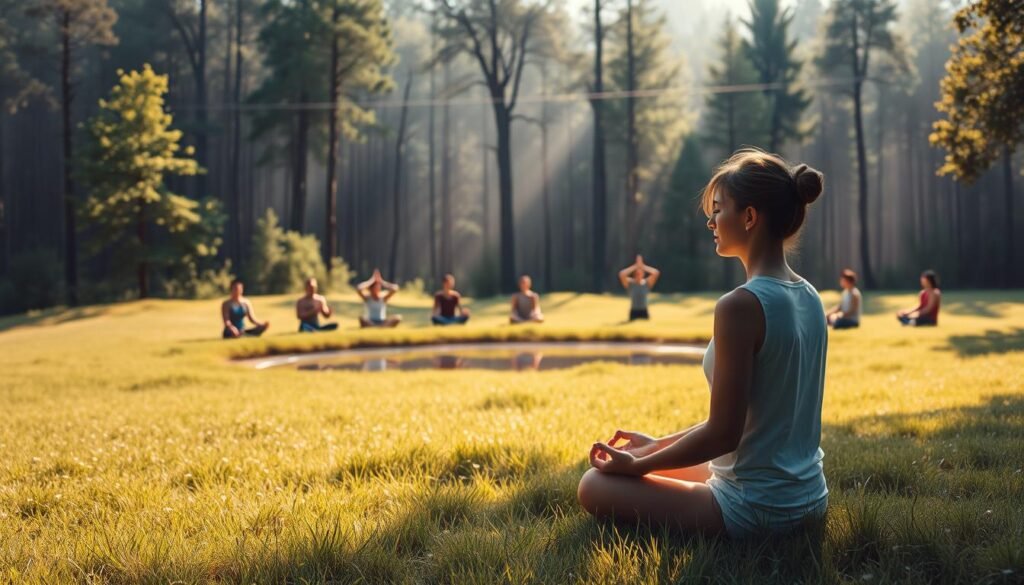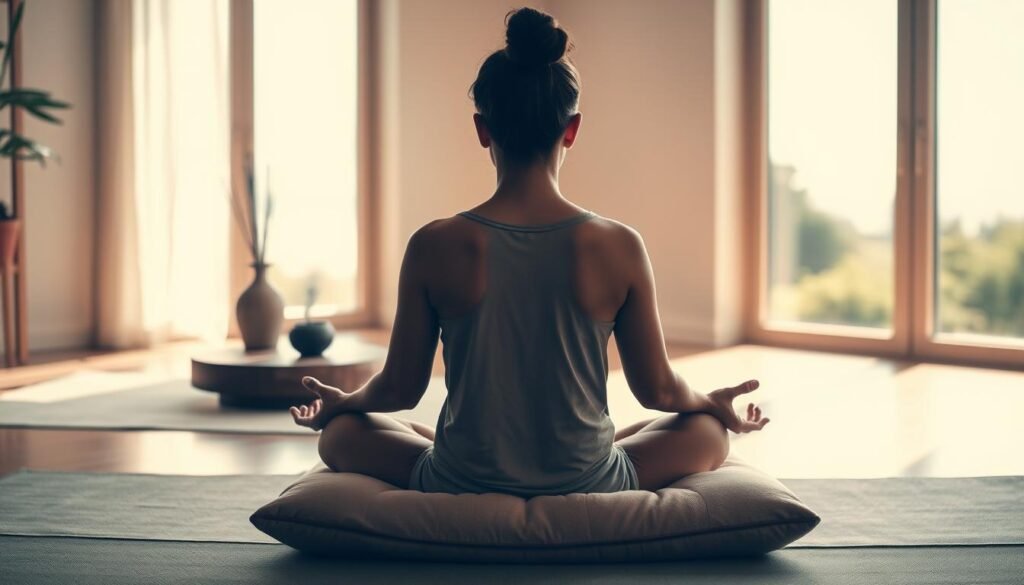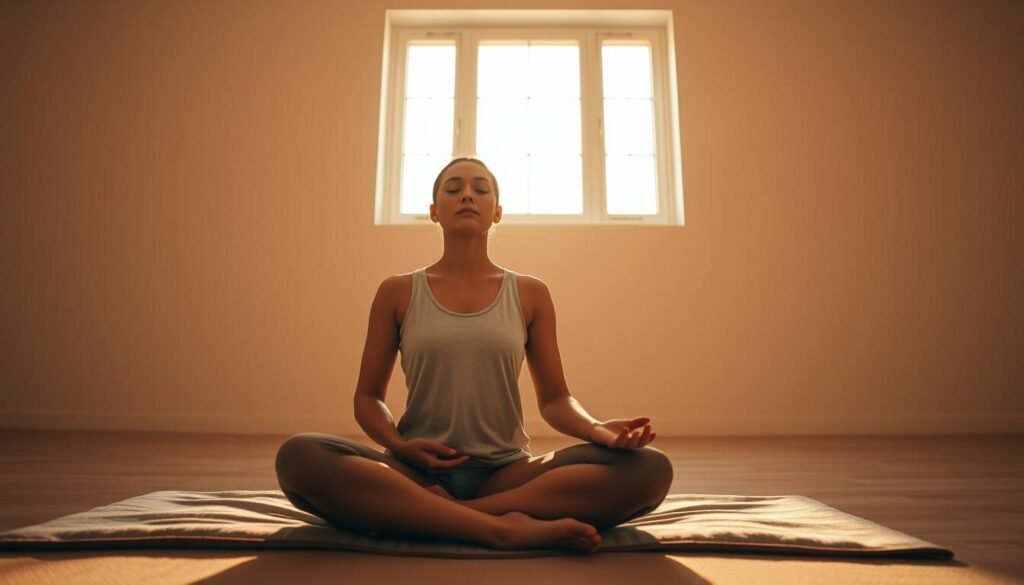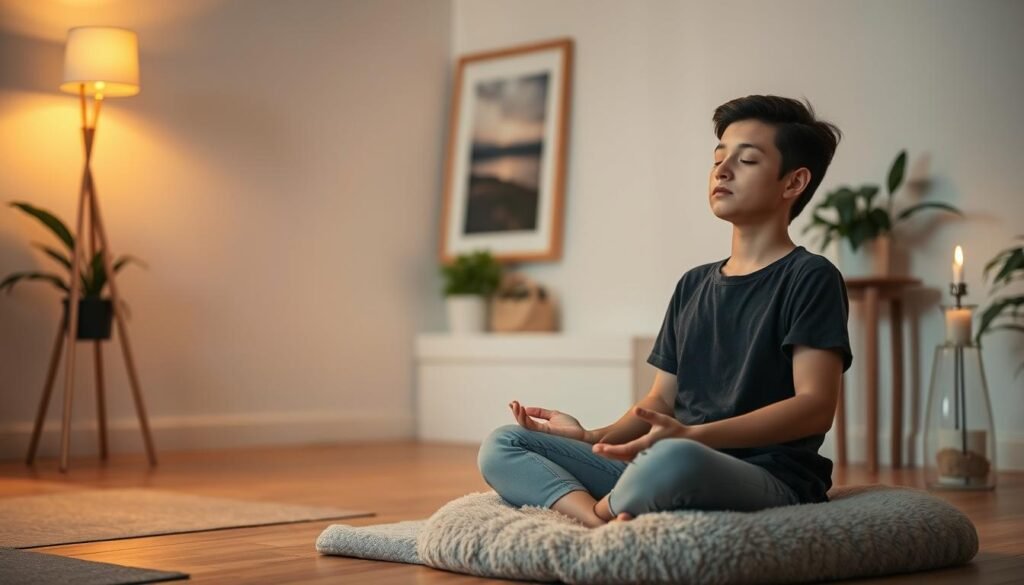Mindfulness for Beginners: 5 Simple Techniques to Reduce Stress Daily

This short guide offers a clear plan to help you reduce stress daily with five simple practices. It meets people where they are, using short, repeatable steps that fit into ordinary life.
The article explains how present-moment awareness calms the brain-and-body response that links stress to higher blood pressure, heart rate, and blood sugar. Research shows paced breath and brief meditation can activate the parasympathetic system and improve focus, mood, and coping.
Expect small sessions to win over long, rare marathons. Short, consistent practice compounds benefits over time. You will get practical instructions, troubleshooting for a wandering mind, and tips to track how your body and mind feel before and after each practice.
This how-to guide is tailored to beginners and centers on safe, gentle methods you can start today. The five techniques previewed are mindful breathing, a body scan, a seven-step seated meditation, mindful movement, and realistic digital boundaries. Credible resources from WHO, the APA, and Psychology Today are provided for added context.
Key Takeaways
- Short, repeatable practices can help reduce stress daily and support health.
- Paced breath and brief meditation shift the nervous system toward calm.
- Start with minutes, track how your body and mind respond, and build routine.
- Five practical techniques are explained with steps and troubleshooting tips.
- Consistent time investments yield measurable benefits for mood and focus.
Why Stress Builds Up and How Mindfulness Helps Right Now
When demands pile up, the body shifts into a protective alarm mode that can keep people running on high alert.
What stress does to your body and mind
Stress is the brain and body’s adaptive defense system. It becomes harmful when ongoing events, rumination, or uncertainty keep it activated.
Chronic activation raises blood pressure and heart rate, alters blood sugar, and links to sleep disruption and inflammation. Cognition narrows, irritability rises, and avoidance coping can worsen anxiety and perceived stress.
The present-moment antidote to the fight-or-flight loop
Present moment awareness helps people respond with values and choice, not just reaction. Short practices lower amygdala reactivity and strengthen prefrontal control.
- Quick paced exhales can shift the autonomic state within minutes.
- Regular mindfulness training reduces perceived levels of tension and supports mental health.
- Small wins—calmer breathing, clearer perspective—build resilience over time.
For trusted guidance and care, see the National Institute of Mental Health, the APA on stress management, the WHO mental health fact sheet, and mechanistic reviews at NIH/PMC and JMIR Mental Health.
Mindfulness for Beginners: Reduce Stress Daily with a Simple Plan
Pick one simple practice and a fixed time; tiny habits add up to real shifts in mood and focus. Start with an anchor practice such as breathing, a brief body scan, or a short seated meditation that you can do in five to ten minutes.

Set realistic expectations
Choose a consistent hour that fits your life. Morning sessions can set the tone. Evenings help unwind.
Weekly plan and habit tips
- Start: 5–10 minutes at the same time each day to form a routine.
- Rotation example: Monday/Thursday breathing, Tuesday/Friday body scan, Wednesday/Saturday seated meditation, Sunday mindful walk and reflection.
- Stacking idea: attach practice to brushing teeth, post-lunch, or bedtime to lower friction.
Keep progress simple
Track one metric, such as minutes practiced or a quick perceived stress rating before and after. Tiny wins build motivation.
| Day | Practice | Minutes | Quick Tip |
|---|---|---|---|
| Mon/Thu | Mindful breathing | 5–10 | Use a soft timer |
| Tue/Fri | Body scan | 5–10 | Lie down or sit |
| Wed/Sat | Seated meditation | 5–10 | Count breaths to anchor |
| Sun | Mindful walk | 10–20 | Notice sensations |
On busy days, try two-minute paced exhales or three mindful breaths. Add two minutes each week until the habit fits without strain.
Note: Expect the mind to wander. Success is gently returning attention, not perfect concentration. For structured courses and more guidance, see Psychology Today’s overview and MBSR programs discussed later in Section 9.
Mindful Breathing to Activate the Relaxation Response
A short breath routine gives a fast, reliable way to calm the nervous system and clear the head. Try this when you need a reset before a meeting or after a tense moment.

How to practice paced exhale breathing for calm
Sit upright and relax the shoulders. Inhale gently through the nose for about four counts. Exhale softly for six to eight counts.
Repeat in sets of 12. Add a soft chin tuck hold after the inhale for five counts before the exhale as a simple variation.
“Stress breath” cues that engage the vagus nerve
Start with an audible exhale like fogging a mirror: soft “haaa,” then close the mouth and continue the gentle sound through the nose. That throat resonance cues the vagus nerve and can lower heart rate and blood pressure.
Common obstacles: wandering mind, judging your practice
If the mind wanders, note “thinking” and gently come back on the next exhale. If judgment appears, label it “judging” and return attention to the nostrils or throat.
Quick tips:
- Body-mapping: place hands on chest and belly to notice movement and physical sensations.
- Safe doses: 1–3 minutes before meetings, 5 minutes midday, 2 minutes before bed.
- Journal briefly on how the body and mind feel before and after a set to track small gains.
| Technique | Counts | When to use |
|---|---|---|
| Paced exhale | 4 in / 6–8 out | Before work transitions |
| Chin-tuck hold | Hold 5 after inhale | After stressful calls |
| Stress-breath resonance | Audible “haaa” then nasal hum | Quick anxiety reset |
For background on breathing methods and longer programs, see the APA’s stress management resources and practical advice at Greater Good, which support simple habits that help paying attention to breath and boundaries.
Body Scan Meditation to Release Muscle Tension
A guided sweep of attention through the body can reveal small tension hotspots before they turn into pain. This short practice trains gentle awareness and helps you notice physical sensations without judgment.

From feet to head: noticing sensations step by step
Settle comfortably and close your eyes if safe. Take a few breaths to steady attention, then begin at the toes.
- Slowly move up: calves, knees, thighs, hips, belly, chest, shoulders, arms, hands, neck, jaw, scalp.
- At each spot, note warmth, tightness, tingling, pressure, or neutrality without trying to change anything.
- Use neutral labels like tight, warm, or numb to support a calm, focus present state.
Progressive tension vs. mindful observation
Progressive relaxation asks you to briefly tense and release groups to spot holding patterns. Mindful observation asks you to notice sensations without altering them.
A blended option works well: try one round of gentle tension-release in shoulders, jaw, and hands. Then continue with a pure observational scan to deepen awareness.
- Practice time: 5–10 minutes; if rushed, scan shoulders, jaw, and belly only.
- Pair the scan with soft breath awareness; when thoughts intrude, acknowledge and return to the next region.
- Use this after work, before sleep, or during a short break to ease accumulated tension and help posture.
Tip: For a quick, eyes-open scan at a desk, notice feet on the floor and back on the chair to bring body awareness into routine tasks. See Psychology Today’s mindfulness primer for basics and check Section 9 for guided practices and longer audio-led body scan meditation.
Beginner-Friendly Mindfulness Meditation for Everyday Life
A compact seated routine can sharpen focus and shift mood in just a few quiet minutes. The practice below fits into work breaks or a brief morning pause.

A seven-step seated practice to focus on the present moment
- Set a time: choose 10–20 minutes (even 5 minutes helps).
- Sit upright: support your back, feet grounded, hands relaxed.
- Close or soften the eyes and take a few settling breaths.
- Anchor on breath: silently cue “breathe in / breathe out” at the nostrils or chest.
- Notice sensations in sight, sound, touch—then return to breath.
- When thoughts arise, label “thinking” and gently come back to the next exhale.
- Close gently: stop labeling, sit quietly a minute, then open eyes slowly.
Gentle strategies to return attention when thoughts intrude
Expect wandering. Labeling thoughts without judgment is the core skill. If sleepiness or restlessness appears, shorten the session or open the eyes and try a guided meditation track.
Loving-kindness as a mood and anxiety support
End with two minutes of warm phrases: May I be safe. May I be well. May I be at ease. Then extend the same wishes to a friend, a neutral person, and all people. This small part boosts mood and calms reactivity.
Mindful Movement: Walking, Yoga, and Everyday Activities
Move with gentle attention and you can turn ordinary motion into a quick reset for the nervous system.
Turn routine movement into a focus-on-breath practice
Mindful walking basics: notice how the feet meet the ground. Match a comfortable breathing rhythm to your steps. Keep the head level and let the arms sway naturally.
Micro-practices work well. Walk to the mailbox or down a hallway for one to three minutes. Pay attention to physical sensations and breath to reset between tasks.
A gentle yoga option can be short and safe. Pick two or three familiar poses like mountain, forward fold, and a seated twist. Move slowly and use a chair or wall if you need support.
- Pair movement with two slow breaths per step or a soft exhale in balance poses.
- Integrate into life tasks: dishwashing, desk stretches, or stairs—notice posture and sensations.
- Practice outdoors when possible to add sound and light as anchors.
| Practice | Duration | Key focus |
|---|---|---|
| Mindful walk | 1–5 min | Feet contact + breathing |
| Mini yoga sequence | 3–7 min | Alignment + breath |
| Movement micro-break | 1–3 min | Physical sensations + posture |
Safety note: move within comfort, avoid pain, and use props. Jot a quick note on how the body feels before and after to track health gains and keep practice steady. These short bursts complement seated meditation and body scans while helping lower stress and build focus present.
Digital Detox Techniques to Lower Daily Stress Load
Small changes to how you use a phone can free chunks of time and calm the nervous system. Excessive device use fragments attention and keeps the mind in a state of partial alert. That partial attention raises perceived stress and can worsen anxiety on busy days.
Simple phone boundaries that protect attention
- No-phone zones: keep devices out of the bedroom and off the dinner table to limit night awakenings and preserve mealtime presence.
- Check windows: set two brief times a day for email and social apps instead of constant scanning.
- Turn off extras: disable nonessential notifications to cut cognitive switching costs and lower reactivity.
Short detox challenges you can actually keep
Try realistic, time-bound trials: a 24-hour social media pause, mornings with no apps until 10 a.m., or a week of one-app-at-a-time use. Keep rules clear and share the goal with a friend for accountability.
Pair these limits with quick micro-practices: when tempted to scroll, take three breathing breaths or a 60-second body scan. Place the phone in another room to support better sleep and winding down.
| Challenge | Duration | Expected benefits |
|---|---|---|
| Notification-free mornings | Until 10 a.m. | Better focus, calmer start to the day |
| 24-hour social pause | One weekend day | Less comparison, more reclaimed time |
| One-app-at-a-time | 7 days | Lower multitasking, improved attention levels |
Quick wins: people report faster sleep onset, fewer mood dips tied to online comparison, and more time for restorative activities. Track perceived stress before and after a week to see health benefits and refine the plan.
Build Your Daily Routine and Track Health Benefits
Create a compact plan that links short practices to set moments in your day. This way you gain clear data on how practice affects sleep, mood, and energy.
MBSR, guided meditations, and apps to try
Mindfulness-based stress reduction is the most-studied eight-week program and can improve attention and perceived stress. Consider the free Palouse Mindfulness course or UMass Center for Mindfulness MBSR listings for structured training.
Apps such as Headspace and The Mindfulness App offer short guided meditations and reminders. Use recorded meditations to keep a routine and to vary practice when motivation dips.
Pair practice with steady eating to stabilize energy
Pair two anchor times (morning and evening) with simple nutrition habits: regular meals, lean protein, and fiber-rich plants. CDC and Harvard Nutrition Source guidance can help plan steady meals that support focus and levels of energy.
“Small routines plus tracking reveal real health benefits over weeks.”
- Track minutes, perceived stress, sleep quality, and energy.
- Plan B: two-minute breath reset and a quick stretch on busy days.
- Adapt the mix to your schedule; rotate practices to stay engaged.
Outcome: a steady routine can lower reactivity, support blood pressure improvements, and boost mental health over time.
Conclusion
A single three-minute routine can act as a reset and begin to change how your head and body respond to pressure.
Small, consistent practice meets the present moment with steadier attention and less reactivity. The five techniques—paced breathing, a short body scan, seated meditation, mindful movement, and simple digital boundaries—work together to lower rumination and lift mood.
Start with one easy habit today: three minutes of paced exhale or a brief body scan meditation before bed. Over time you may see benefits in sleep, mood, and even blood pressure.
Wandering thoughts and self-judgment are normal; notice them and gently return attention. Consider guided meditation, MBSR courses, and the resources below to deepen practice and sustain gains.
Resources: WHO; NIMH; APA; Greater Good; Lifeline; Psychology Today; JMIR 2024; NIH/PMC; CDC; Harvard Nutrition; Blue Zones resources.





